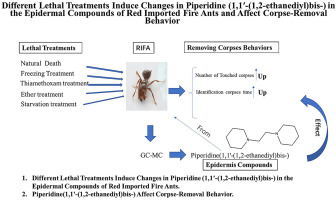Ecotoxicology and Environmental Safety ( IF 6.2 ) Pub Date : 2020-03-07 , DOI: 10.1016/j.ecoenv.2020.110391 Deqiang Qin 1 , Peiwen Zhang 1 , You Zhou 1 , Qun Zheng 1 , Ruiquan Hou 1 , Benju Liu 1 , Jianjun Chen 2 , Zhixiang Zhang 1

|
Corpse-removal behavior of the red imported fire ant (RIFA) and the effects of lethal substances on RIFA signal communication were investigated in this study. The RIFA corpses, obtained through freezing, ether, 0.25 mg/L thiamethoxam, and starvation to death treatments, and naturally dead red fire ants were subjected to gas chromatography–mass spectrometry to identify the cuticular hydrocarbon profiles that had an effect on the corpse-removal behavior. The results showed that lethal toxic substances altered the epidermal compounds of RIFA and affected their corpse-removal behavior. Lethal toxic substances increased the number of worker touches with corpses and identification time of corpses. In addition, the content of piperidine (1,1′-(1,2-ethanediyl)bis-) on the surface of the corpse was different following the various treatments. Contamination with toxic substances resulted in the increased secretion of piperidine and led to increased identification time of corpses, number of touch with corpses, and total time for removal of corpses. Piperidine content was higher under conditions of natural death (4.67 ± 0.55%) and with thiamethoxam (10.43 ± 0.78%), freezing (0.83 ± 0.25%), and ether treatment (12.50 ± 0.70%) than under starvation treatment (0). The higher content of piperidine led to a longer number of touches with corpses and identification time. Piperidine compounds may be an element in warning information, which could affect the occurrence of different corpse-removal behaviors.
中文翻译:

不同的致死性处理会导致红色进口火蚁的表皮化合物中哌啶(1,1'-(1,2-乙二基)双-)发生变化,并影响尸体去除行为。
在这项研究中,研究了红火蚁(RIFA)的去除尸体行为以及致命物质对RIFA信号通讯的影响。通过冷冻,乙醚,0.25 mg / L的噻虫嗪和饥饿饿死的方法获得的RIFA尸体,以及自然死亡的红火蚁经过气相色谱-质谱分析,以确定对尸体有影响的表皮碳氢化合物分布。去除行为。结果表明,致命的有毒物质改变了RIFA的表皮化合物并影响了其去除尸体的行为。致命的有毒物质增加了工人与尸体接触的次数以及尸体的识别时间。另外,在尸体表面上,经过各种处理,哌啶(1,1'-(1,2-乙二基)双-)的含量不同。被有毒物质污染导致哌啶的分泌增加,导致尸体的识别时间增加,与尸体接触的次数以及清除尸体的总时间增加。在自然死亡条件下(4.67±0.55%)和噻虫嗪(10.43±0.78%),冷冻(0.83±0.25%)和乙醚处理(哌啶)的条件下,哌啶含量高于饥饿处理(0)。较高的哌啶含量导致与尸体和识别时间的接触次数更长。哌啶化合物可能是警告信息中的一个因素,可能会影响不同的尸体去除行为的发生。在自然死亡条件下(4.67±0.55%)和噻虫嗪(10.43±0.78%),冷冻(0.83±0.25%)和乙醚处理(哌啶)的条件下,哌啶含量高于饥饿处理(0)。较高的哌啶含量导致与尸体和识别时间的接触次数更长。哌啶化合物可能是警告信息中的一个因素,可能会影响不同的尸体去除行为的发生。在自然死亡条件下(4.67±0.55%)和噻虫嗪(10.43±0.78%),冷冻(0.83±0.25%)和乙醚处理(哌啶)的条件下,哌啶含量高于饥饿处理(0)。较高的哌啶含量导致与尸体和识别时间的接触次数更长。哌啶化合物可能是警告信息中的一个因素,可能会影响不同的尸体去除行为的发生。











































 京公网安备 11010802027423号
京公网安备 11010802027423号